Women and those classified as female at birth (AFAB) will go through more than 400 periods in their lives and use over 10,000 items to assist control their menstruation. Although controlling menstruation is a common experience, it can be costly for the user and have an adverse effect on the environment due to the waste products that are produced. Alternative methods, such “leak-free” period panties, have been developed more recently to control menstruation more responsibly and economically. What precisely are period underpants, and what are the opinions of gynecologists regarding them?
What is period underwear?
Period or period underwear is a reusable item that can collect blood from the menstrual flow to stop it from dripping onto clothing. These underwear not only appear and feel like your typical underwear, but they also serve as period products, which is an added bonus. Tampons, pads, or other menstrual supplies can be replaced with period underwear, which can be worn on its own throughout your period to collect period blood. Nevertheless, depending on your needs, you might decide to pair your period panties with other menstrual products for extra protection.
According to author and practicing gynecologist Alyssa Dweck, MS, MD, FACOG, “period underwear can be utilized as a stand-alone menstrual product or in combination with others for confidence as it pertains to fear of leakage.”
How do period pants work?
Period underwear consists of absorbent undergarments with a period pad sewed in. This absorbent part is made of multiple layers of polyester microfiber, with a liquid-repellent coating, nylon, and lycra on the outside. The combination produces a breathable, fast-drying clothing that draws menstrual blood away from the body, increasing wearer comfort and guaranteeing leak-proof protection.Because each person’s menstrual blood levels are different, some period underwear is more absorbent for lighter periods and less absorbent for heavier flows.
Do gynecologists recommend period underwear?
For a variety of reasons, many gynecologists advise their patients to use these alternative products. Dr. Alexa Fiffick, a qualified OBGYN and national authority on menopause, reproductive health, menstruation, and other women’s health issues, says, “If it is pleasant for the patient and is cost-effective, I do.”
OBGYN Dr. Matthew Casavant has over 20 years of expertise and considerable training in women’s health. He frequently recommends period underwear to patients “who experience severe menstrual bleeding or incontinence.” In addition to being inconspicuous and well-liked by most users, the underwear has several advantages over conventional menstruation products.
Safety
Menstrual underwear is considered a very safe alternative to traditional period products. For one, wearing tampons for an extended period or using ‘super absorbent’ tampons is a potential cause of toxic shock syndrome (TSS). Apart from associations with tampon use, menstrual cups have also infrequently been linked to TSS, an uncommon illness that can arise from the bloodstream being contaminated by dangerous germs. Wearing external period products such as period underwear can significantly lower the chance of developing TSS.
In addition, a rare concern regarding the possible expulsion of intrauterine devices (IUDs) with menstrual cup use can be avoided with menstrual underwear.
Menstrual underwear should still be changed on a regular basis to prevent the fabric from becoming a haven for different microorganisms that cause odor. Wearing the same period panties for days on end is not advised, even with little flow.
Effectiveness and comfort
Menstrual underwear has been demonstrated to be not only safe but also effective and comfortable for the majority of users.Period underwear is often more pleasant for the wearer than using a pad or tampon throughout the day because it is composed of soft, breathable material.According to Dr. Casavant, “it offers a discrete, pleasant substitute for conventional hygiene products and can be especially helpful post-partum when women may experience erratic bleeding.”
However, this may not be the case for some users, advises Dr. Fiffick, such as patients who may be unable to tolerate them due to “vulvodynia, allergy, or sensitive skin.”
Sustainability
Period or menstrual underwear is made of washable materials, allowing women to wear them multiple times. In addition, some period underwear can be reused for six months to two years. By comparison, disposable pads and tampons are made of plastics such as polyester, with pads containing up to 90% of plastic.
“They [period underwear] are usually machine washable and reusable. Many women opt for period underwear for environmental purposes; there is less product waste,” said Prof. Tanja Premru-Sršen, M.D., Ph.D., Chief Medical Advisor for Bellabeat.
This sustainability aspect can also mean considerable cost savings for users. “For instance,” says Dr. Casavant, “patients have reported significant savings after six months of using quality brands, despite an upfront higher cost.” In one study, the cost savings were estimated to be ~$205 (the equivalent of ~1,000 single-use tampons) for women and AFABs in countries like the United States. So, while the initial investment may be higher in menstrual underwear compared to traditional products, it’s one investment that can pay off in the long term.
Period underwear: how to choose
Making a decision about period underwear can be difficult for first-time buyers because to the abundance of manufacturers available, but focusing on a few key aspects will help you make a more informed choice.
- Inventory. One thing to think about is how many products you would need to buy depending on how often you menstruate. It will influence the absorbency level you need to choose (and, presumably, how many of each absorbency to purchase), just as those with heavier periods have different demands from those with lighter ones.
- Costs. Period underwear may generally be found between $10–$65, with quality goods being found at either end of the spectrum. Nevertheless, it is crucial to take the initial cost into account. For instance, buying 5-7 pieces at first can be necessary to replace all of your period necessities with menstruation underwear right away, without having to wash them before using them again in the same cycle.
- Preferences and/or lifestyle. Your preferences, dislikes, rituals, and habits are also very significant considerations. Taking these into consideration will assist in determining whether it is best to hunt for extra goods to support a really athletic and busy lifestyle, or only buy a high-waisted brief, for example.
So where should we begin? Just buy one pair of underwear with the absorbency level you need and in a style you are accustomed to from a reputable brand. Next, put it on to see how long it holds before you feel the urge to change, and then proceed accordingly.”Trying different brands and styles might be necessary to find the perfect fit.” as Dr. Casavant pointed out.For those who can afford it, several businesses also provide a starter kit that allows you to try out different styles and absorbency levels during your cycle. Also, some companies provide a starter kit for trialing multiple styles and absorbency levels throughout your cycle, which can be a helpful option for users who can afford to purchase one.
Types of period underwear
The first way to classify period underwear is by absorbency levels. Absorbency levels range from mild to heavy, with some period underwear able to absorb 5-7 tampons’ worth of blood in a 12-hour period. This terminology is similar to that used for pads and tampons. Thus, for instance, a person who has three days of heavy flow and four days of light flow throughout a 7-day period can buy the appropriate amount of both high- and light-absorbency underwear. Remember that a thicker layer in a product line corresponds with increased absorbency, so selecting an absorbency that meets your demands may be more comfortable and hence more advantageous.
Similar to regular underwear, these products also come in various types of styles.
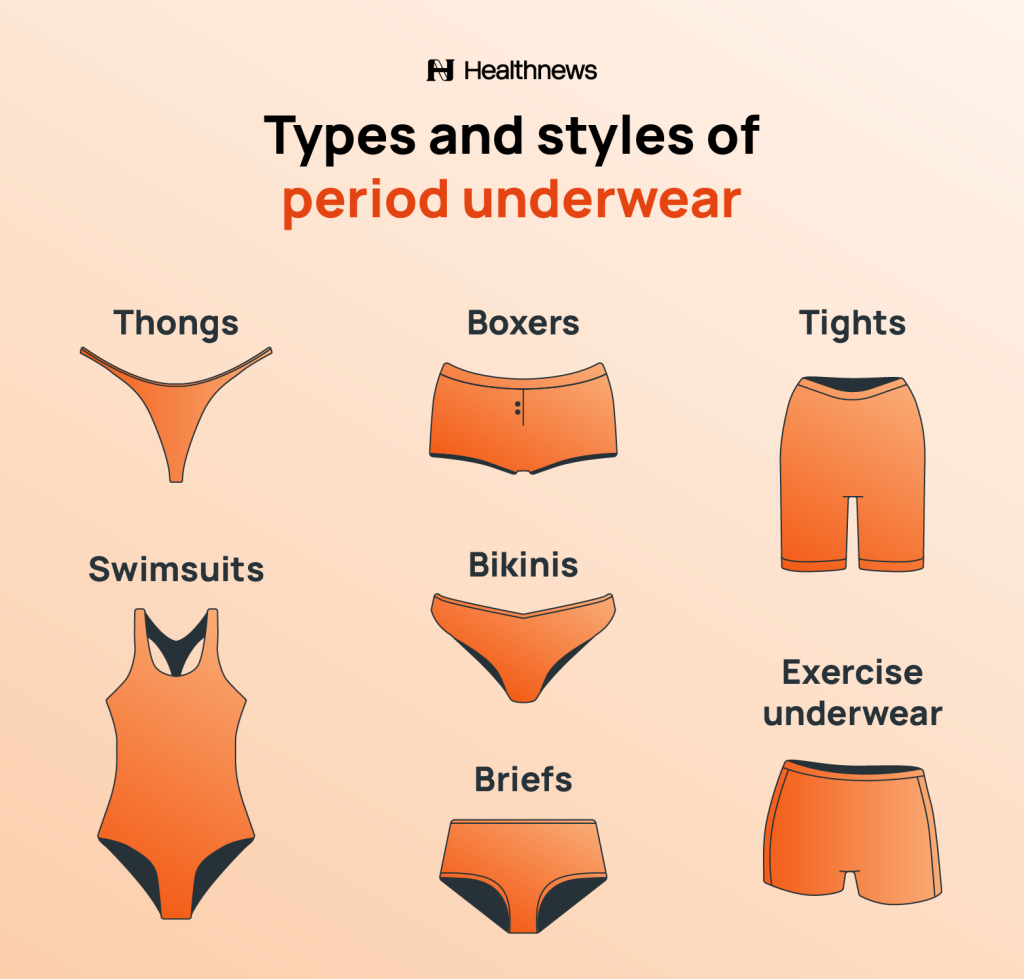
Benefits of period underwear
There are many advantages to wearing period underwear. When weighed against more conventional period products, they can be:
- Comfortable. When opposed to pad alternatives, period undies are generally more comfortable for consumers because they feel like your normal underwear.
- Sustainable. Menstrual underwear’s reusable nature can save consumers money over time and lessen the environmental effect of period hygiene items.
- Environmentally-friendly. In contrast, just one period panty may be able to reduce the need for four to eight tampons per day.
- Safe. Menstrual underwear, when worn and maintained appropriately, is linked to notably reduced incidence of TSS than tampons. As of right now, no research has demonstrated that using menstrual underwear has any negative impacts.
- Effective. Menstrual underwear has the capacity to contain six to eight times the fluids of a tampon, meaning that it may be used for up to 12 hours without leaking.
- Convenient and flexible (in some aspects). There’s no learning curve, and (in ideal cases) can is no need to switch to another product during the middle of the day. Additionally, products may “offer flexibility when adjusting to new contraceptives or during perimenopause, as bleeding can be unpredictable,” says Dr. Fiffick.
- Accessible (for some users). Menstrual underwear, for instance, may more effectively support menstrual hygiene objectives for individuals with physical or visual disability.
These reasons are why many gynecologists and menstrual health experts advocate for their use.
Disadvantages of period underwear
However, there are also a few possible disadvantages to consider:
- Uncomfortable sensations. Patients who tend to prefer “intravaginal period products” may find the “sensation of menstrual flow unpleasant,” according to Dr. Fiffick. Additionally, as clots may “remain on the surface of the product,” patients with “frequent clotting with their periods may not be a good fit for menstrual underwear.”
- Specific care requirements. Period underwear frequently requires special cleaning techniques that may not apply to regular underwear; failing to follow these instructions may shorten the product’s lifespan and effectiveness.
- Lack of regulation. There are no laws requiring absorbency ratings, for example, unlike with pads and tampons, so choosing between brands and types could take more trial and error.
- High upfront costs. A single-period panty can cost as much as one to four boxes of tampons, and it can be used for up to 12 hours before needing to be washed and dried by air.
- Affordability. Some users might not be able to afford these menstrual underwear due to the upfront price, let alone buy enough underwear to last the duration of a period.
- Per- and poly-fluoroalkyl substances (PFAS) concerns. PFAS, ‘forever chemicals’ associated with multiple health risks and frequently used in water-resistant and non-stick products, have been found in common menstrual products.
- Inconvenience (in other aspects). Having to handle and store both clean and used underwear while away from home may be problematic for people with very heavy flows, health issues, or just a matter of preference.
Purchasing period panties from reputable brands and testing one at a time will help mitigate some of these drawbacks. If the menstrual underwear matches your needs, you can use it in addition to your current items to address other difficulties.
Furthermore, Dr. Fiffick cautions that although “3,000+ chemicals that qualify as PFAS,” it may be challenging to ensure an item is PFAS-free. Nevertheless, Dr. Casavant advises looking for firms that are “transparent about their materials and manufacturing processes,” and choosing to buy products that have been certified to be free of dangerous chemicals like PFAS. (More precisely, “PFAS-free,” not just “PFOA-free,” which refers to a product free of certain but not all PFAS compounds).
How to use period underwear
With proper care, menstrual underwear can last up to two years. Given the expense of purchasing them, a lot of consumers will want to use each pair for as long as feasible. There are a few easy techniques to make your underwear last longer.
Preparation
You will eventually need to acquire at least one item for every other day of your period, if you do not mind carefully washing, drying, and then rewearing your period underwear. If not, think about increasing your inventory such that you have two pairs of underwear for every day that you get your period.
Furthermore, even a “high absorbency” choice may need to be changed in less than 12 hours for people experiencing extremely heavy bleeding in order to prevent leaks or just an uncomfortable feeling from the absorbed liquid. This can mean that you need two or more period panties every day, or that you choose to use other means, such a menstrual disc or reusable pad, to double up on sanitary napkins during your cycle.
Wearing menstrual underwear
Luckily, menstrual underwear is put on just like you would your regular underwear. After that, you just carry on with your day, watching for leaks or being aware of any uncomfortable feelings. This can assist you in assessing whether the style and fit suit you well, whether you have any sensitivity issues (such as allergies or friction) with the product’s material, and whether it might be time to switch out your period underwear. You have found an effective period product if it keeps you cozy and provides odor- and leak-free protection for as long as it is convenient for you.
It is a good idea to wash new clothes, including your underwear, before wearing them for the first time to minimize any potentially dangerous chemicals that may have been used during production.Additionally, to assist your menstrual product last longer, if you use it especially for your period, use it exclusively during your period and wear ordinary underwear in between cycles.
How often to change menstrual underwear
To avoid leaking and odor, you must change your menstruation underwear on time. You will have to test your period product, just as you would with traditional products, in order to determine what this timeframe would be for you. Many users pick up on changing their underwear frequently enough to ensure comfort, hygiene, and the best possible use of their other menstrual product. It is advisable to avoid wearing the underwear for more than 12 hours, though.
You will need to rinse and/or soak your underwear in water when it is time to change in order to get rid of the menstrual blood. Next, to preserve the product, handwash the underwear or wash it inside a delicate bag. To prolong the life of the product and prevent period underwear from tearing, it is advised to let them air dry after washing. When wearing the product again, wait until it dries completely, which usually takes a day. Once you have discovered that your product is damaged with holes or tears, or is no longer functional (i.e., lacks absorbency), it is time to replace it.
Using a backup with your period underwear
Period underwear is a backup option for those who prefer to use intravaginal items, such as menstruation cups and discs, to prevent leakage.For heavy users who wish to prolong the interval between changing or emptying their menstrual products, this can be a useful solution. However, as period underwear is made to be a stand-alone item, using a backup is frequently entirely optional. The primary determinants of period underwear’s compatibility with your monthly hygiene regimen are user demands and preferences.
Period underwear has been demonstrated to be safe and frequently a more comfortable option for menstrual hygiene. It can also be more environmentally friendly for both users and the environment. However, choosing your ideal pick on the first try could be difficult given the wide variety of styles and brands available. PFAS is also a real health risk that consumers need to be mindful of, but it can also be present in other menstruation items like pads and tampons. Get a starter kit or a single pair of underwear from a reputable brand, tailored to your needs and desired style, to give this product a try at a reasonable price. In addition, please heed the advice provided by the manufacturer while selecting and maintaining your period product.Finally, you should think about seeking expert medical counsel from your gynecologist if you have questions about whether period underwear is right for you.
FAQ
What type of underwear is best for periods?
There is no one “optimal” style of menstrual underwear; rather, what works best for each individual depends on their needs and tastes. But always choose underwear that is advertised as being devoid of dangerous substances like PFAS.
Are you supposed to wear pads with period underwear?
Not always. Period underwear is primarily made to be stand-alone items with an integrated pad for absorption. Users who have other demands or experience excessive bleeding may want to think about combining pads with menstrual underwear.
Can you wear period underwear with a heavy period?
Yes.People who endure severe bleeding are often advised to use period underwear. Menstrual underwear should be used in conjunction with other supportive period goods, such as menstrual cups or discs, for those who bleed really heavily.
Key takeaways:
- A great substitute for pads, tampons, or menstruation cups is period underwear.
- Moisture-wicking materials, including microfiber polyester, are used in the design of period underwear to assist stop leaks.
- Period underwear is useful for bladder leaks, vaginal discharge, and postpartum hemorrhage in addition to menstruation.
- Period underwear is comfortable and environmentally beneficial, however worries about potential PFAS contamination and the cost of purchasing the underwear can be concerning.
- Period underwear is advised by many gynecologists as a means of controlling menstruation.





Leave a Reply